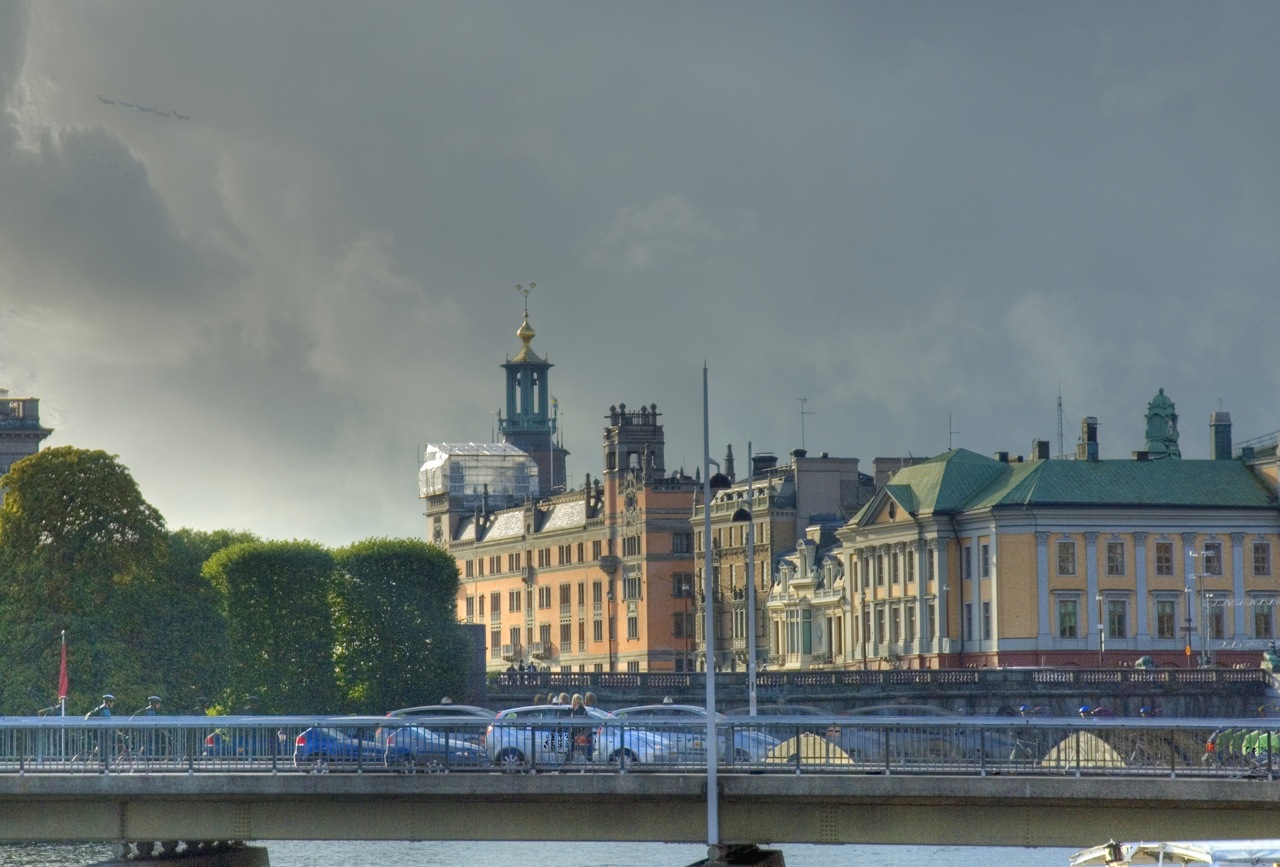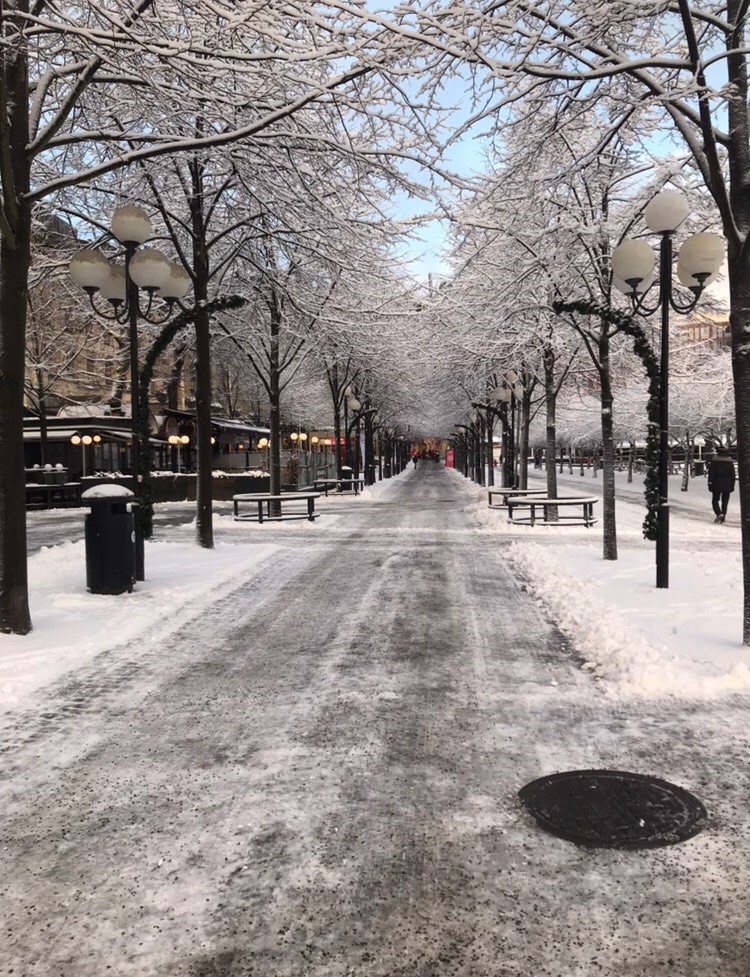|
Strömbron
Strömbron (Swedish: "The Stream Bridge") is a viaduct in central Stockholm, Sweden. Stretching over Norrström, it is connecting the old city Gamla stan to the northern-central district Norrmalm, or, more specifically, to Blasieholmen near the park Kungsträdgården. History Though initially put forward by the influential city planner Albert Lindhagen (1823–1887) in 1866, a bridge on the current location was never included in any of his district-level city plans. In 1874 however, the Building Society of Stockholm (''Stockholms byggnadsförening'') required permission to construct a toll-financed bridge stretching from the northern end of Skeppsbron to connect directly to Stallgatan, thus with a more eastern course than the present bridge. Though favourably disposed towards the proposal, the City Council made several demands, asking for the direction of the bridge to be changed, fixing its width to 58 feet (17.4 metres), settling the tariff to 2 öre for pedestrian a ... [...More Info...] [...Related Items...] OR: [Wikipedia] [Google] [Baidu] |
Vasabron
Vasabron (Swedish: "The Vasa Bridge") is a bridge over Norrström in central Stockholm, Sweden connecting Norrmalm to Gamla stan, the old city. The bridge is, unintelligibly, named after King Gustav Vasa (1496–1560), perhaps because of the vicinity to the statue of the king in front of the House of Knights. From Vasabron a much smaller bridge, Strömsborgsbron, connects to the islet Strömsborg. Nearby bridges include Riksbron, Stallbron, Norrbro, Centralbron, and Strömbron. History By the mid-19th century Stockholm was expanding quickly and the single permanent northern connection at the time, Norrbro bridge, was becoming inadequate, which is why a new bridge to the west of it was proposed. The first attempt to build the bridge was made by the British-Swedish engineer and industrialist Samuel Owen (1774–1854). He began to work on a suspension footbridge soon after an agreement with the city was settled, but the work had to be cancelled when Owen was declared bankrupt i ... [...More Info...] [...Related Items...] OR: [Wikipedia] [Google] [Baidu] |
Stallbron
Stallbron (Swedish: "The Stable Bridge") is an arch bridge located in Gamla stan, the old town in central Stockholm, Sweden. Stretching some 20 meters over Stallkanalen it connects Riksgatan passing through the Parliament Building on Helgeandsholmen to the square Mynttorget on Stadsholmen from where Västerlånggatan extends it further south. It was named in the late 19th century after the Royal Stables which king Gustav Vasa had built on Helgeandsholmen in the 1530s, thereafter rebuilt by Karl IX 1604–12, and finally demolished in 1640 when the present stables were completed on Norrmalm, one km to the north. History Occupying one of the most central locations in Stockholm, Stallbron is, arguably, the site of the oldest bridge in the city. An earlier wooden bridge was found at this location, forming part of what was northern gate of the city, called ''Norrbro'' ("Northern bridge") and later ''Norrbrogatan'' ("Northern Bridge Street"). As an extension to Västerlång ... [...More Info...] [...Related Items...] OR: [Wikipedia] [Google] [Baidu] |
List Of Bridges In Stockholm
This is a list of some of the most notable bridges and viaducts in Stockholm, starting with those located closest to the city centre. Many more bridges and viaducts could, of course, be added, including those on the rail and motorway networks, and the many grade-separated junctions in the suburbs which are a product of postwar city planning. Historical * Sveabron (where present-day Odengatan passes over Sveavägen) * Nybro or Stora Ladugårdslandsbron (across today's Berzelii Park) * Näckströms bro (connecting Norrmalm and Blasieholmen) Additionally, during the cold winters in the 19th century, ice in the city harbour made it necessary to replace ferries by temporary pontoon bridges sometimes more than 300 m in length. See also * Geography of Stockholm References {{reflist Bridges Bridges Bridges in Stockholm Stockholm Stockholm () is the Capital city, capital and List of urban areas in Sweden by population, largest city of Sweden as well as the List of ... [...More Info...] [...Related Items...] OR: [Wikipedia] [Google] [Baidu] |
Kungsträdgården
Kungsträdgården (Swedish language, Swedish for "King's Garden") is a park in central Stockholm, Sweden. It is colloquially known as ''Kungsan''. The park's central location and its outdoor cafés makes it one of the most popular hangouts and meeting places in Stockholm. It also hosts open-air concerts and events in summer, while offering an ice rink, Opening hours and some more information. during winters. There is also a number of cafés, art galleries and restaurants; for example Galleri Doktor Glas, a name taken from the novel ''Doctor Glas'' by Hjalmar Söderberg published in 1905. The park is divided into four distinct spaces (south to north): (1) Square of Charles XII; (2) Molin's Fountain; (3); Square of Charles XIII and (4) "Fountain of Wolodarski" (which does not have an official name). The park is administered and events in it organized by the Stockholm Chamber of Commerce. Overview A number of Stockholm landmarks are found around the perimeter of Kungsträ ... [...More Info...] [...Related Items...] OR: [Wikipedia] [Google] [Baidu] |
Skeppsbron
Skeppsbron (Swedish: "The Ship's Bridge") is both a street and a quay in Gamla stan, the old town of Stockholm, capital of Sweden, stretching from the bridge Strömbron in front of the Royal Palace southward to Slussen. The quay Skeppsbrokajen runs along the street. Several alleys connects Skeppsbron to the thoroughfare Österlånggatan: Slottskajen, Lejonbacken, Slottsbacken, Telegrafgränd, Skeppar Karls Gränd, Bredgränd, Kråkgränd, Nygränd, Brunnsgränd, Skottgränd, Stora Hoparegränd, Drakens Gränd, Ferkens gränd, Gaffelgränd, Johannesgränd, Packhusgränd, Tullgränd, Norra Bankogränd, Södra Bankogränd, Norra Dryckesgränd, Södra Dryckesgränd, Slussplan History Skeppsbron is mentioned as ''Stadzbron'' in 1592, ''skeepzbroon'' in 1647, and finally appears as ''Skeppsbron'' in 1961. While no historical documents knows to tell when or why the decision was taken to develop the eastern waterfront of Stadsholmen in accordance to the pretensions of ... [...More Info...] [...Related Items...] OR: [Wikipedia] [Google] [Baidu] |
Norrbro
Norrbro (Swedish for "North Bridge") is an arch bridge over Norrström in central Stockholm. It extends north from the northern front of the Royal Palace passing over Helgeandsholmen in front of the Riksdag building, and from there over to Gustav Adolfs torg. Norrbro was designed by the city architect Erik Palmstedt (1741–1803) in a neoclassical style. History Norrbro was one of the first bridges of Stockholm to be built in stone. It was completed in ten years, with the northern portion, supported by three arches, finished in 1797, and the southern, supported by a single arch, in 1806. Norrbro replaced two old wooden bridges, ''Slaktarehusbron'' and ''Vedgårdsbron'', both demolished on its completion. In many aspects Norrbro remained an unparalleled bridge in Stockholm for a long period, exceeding all other not only by its width (19 m) and span, but also by being the first street to be paved and furnished with separate pavements. For the foundation work of the bridge Erik P ... [...More Info...] [...Related Items...] OR: [Wikipedia] [Google] [Baidu] |
Pontoon Bridge
A pontoon bridge (or ponton bridge), also known as a floating bridge, uses float (nautical), floats or shallow-draft (hull), draft boats to support a continuous deck for pedestrian and vehicle travel. The buoyancy of the supports limits the maximum load that they can carry. Most pontoon bridges are temporary and used in wartime and civil emergencies. There are permanent pontoon bridges in civilian use that can carry highway traffic. Permanent floating bridges are useful for sheltered water crossings if it is not considered economically feasible to suspend a bridge from anchored piers. Such bridges can require a section that is elevated or can be raised or removed to allow waterborne traffic to pass. Pontoon bridges have been in use since ancient times and have been used to great advantage in many battles throughout history, such as the Battle of Garigliano (1503), Battle of Garigliano, the Battle of Oudenarde, the Operation Plunder, crossing of the Rhine during World War II, the ... [...More Info...] [...Related Items...] OR: [Wikipedia] [Google] [Baidu] |
Centralbron
Centralbron (, "The Central Bridge") is a major bridge in central Stockholm, Sweden, connecting the northern district Norrmalm to the southern Södermalm. It is 1,200 metres long and consists of two viaducts passing over Söderström ("Southern Stream") and Riddarfjärden close to Norrström ("Northern Stream") with an interjacent elevated section traversing Riddarholmskanalen and the adjacent eastern waterfront of Riddarholmen. Centralbron has a capacity for 130,000 cars per day. It is paralleled by the bridges (''Södra'' and ''Norra järnvägsbron'') and the tunnel of a two-track railway used by the commuter and freight trains. Centralbron does partly go on top of the Metro which opened on this stretch 1957 and planned together with the bridge. Over the years, Centralbron together with a suggested additional railway track have been much criticized and debated because of their unwieldy and rumbling presence in a delicate historical setting. Lately, the construction of a tunne ... [...More Info...] [...Related Items...] OR: [Wikipedia] [Google] [Baidu] |
Riksbron
Riksbron (Swedish: "The National Bridge" or "The State Bridge") is an arch bridge in central Stockholm, Sweden leading from Drottninggatan on Norrmalm over to Riksgatan on Helgeandsholmen. The name is derived from the bridge's proximity to several buildings of national importance, including Riksdagen, the Parliament Building; Rosenbad, the Prime Minister's Office and the Government Chancellery; and the Sager House, official residence of the Prime Minister. Nearby bridges include Stallbron, Norrbro, and Vasabron. History Writing from his camp at Bender in 1712, King Charles XII (1682–1718) was the first to suggest a bridge extending Drottninggatan over to Helgeandsholmen. In a drawing dated from 1713 the king's architect, Nicodemus Tessin the Younger (1654–1728), not only proposed a new bridge but also wanted to have the street extended much further south, across Helgeandsholmen and over to Mynttorget next to the Royal Palace on Stadsholmen. However, Sweden was at war wit ... [...More Info...] [...Related Items...] OR: [Wikipedia] [Google] [Baidu] |
Trout
Trout are species of freshwater fish belonging to the genera '' Oncorhynchus'', ''Salmo'' and ''Salvelinus'', all of the subfamily Salmoninae of the family Salmonidae. The word ''trout'' is also used as part of the name of some non-salmonid fish such as ''Cynoscion nebulosus'', the spotted seatrout or speckled trout. Trout are closely related to salmon and char (or charr): species termed salmon and char occur in the same genera as do fish called trout (''Oncorhynchus'' – Pacific salmon and trout, ''Salmo'' – Atlantic salmon and various trout, ''Salvelinus'' – char and trout). Lake trout and most other trout live in freshwater lakes and rivers exclusively, while there are others, such as the steelhead, a form of the coastal rainbow trout, that can spend two or three years at sea before returning to fresh water to spawn (a habit more typical of salmon). Arctic char and brook trout are part of the char genus. Trout are an important food source for humans and wildlife, ... [...More Info...] [...Related Items...] OR: [Wikipedia] [Google] [Baidu] |
Salmon
Salmon () is the common name for several list of commercially important fish species, commercially important species of euryhaline ray-finned fish from the family (biology), family Salmonidae, which are native to tributary, tributaries of the North Atlantic (genus ''Salmo'') and North Pacific (genus ''Oncorhynchus'') basin. Other closely related fish in the same family include trout, Salvelinus, char, Thymallus, grayling, Freshwater whitefish, whitefish, lenok and Hucho, taimen. Salmon are typically fish migration, anadromous: they hatch in the gravel stream bed, beds of shallow fresh water streams, migrate to the ocean as adults and live like sea fish, then return to fresh water to reproduce. However, populations of several species are restricted to fresh water throughout their lives. Folklore has it that the fish return to the exact spot where they hatched to spawn (biology), spawn, and tracking studies have shown this to be mostly true. A portion of a returning salmon run ma ... [...More Info...] [...Related Items...] OR: [Wikipedia] [Google] [Baidu] |








